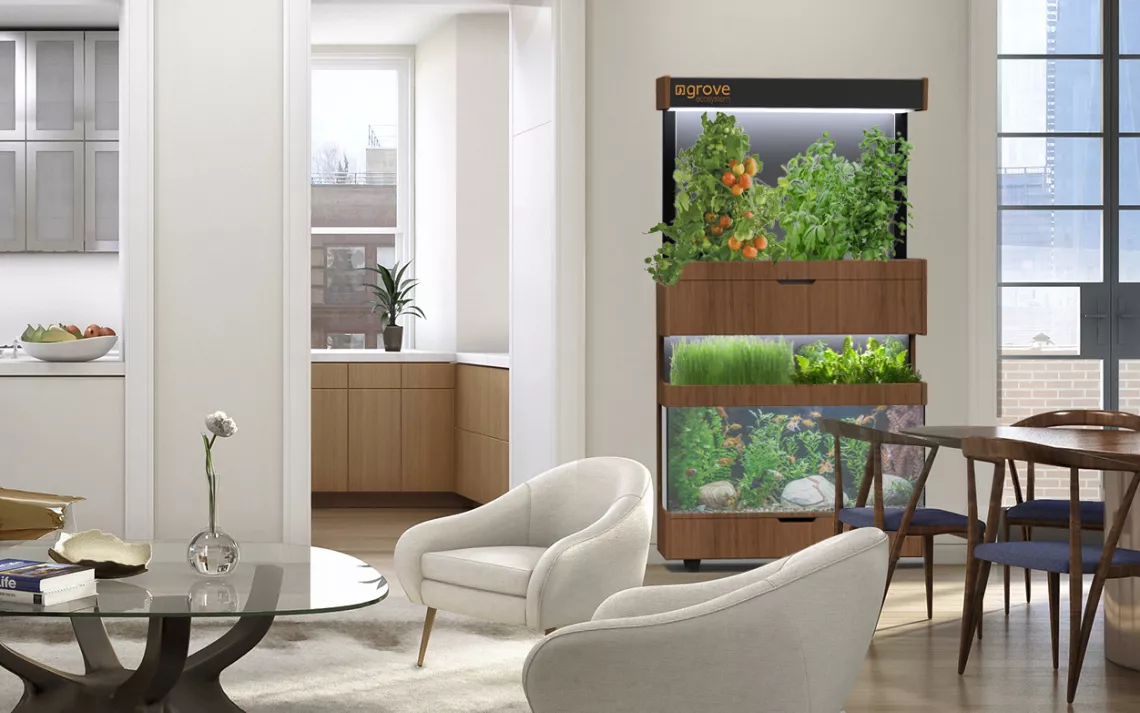Algae Haus
On the Frankenstrasse, in the German city of Hamburg, stands a new apartment building whose walls are covered with green slime. The Bio Intelligence Quotient house, or BIQ, is the result of a daring $6.5 million quest to transform a four-story facade into a living power plant. Billions of algae organisms, contained within 129 glass bioreactors, photosynthesize and multiply like crazy when the sun is out. Roughly every four seconds, the glowing green liquid is disturbed by a burst of growth-promoting air bubbles, making the facade look like a lava lamp. The 15-unit apartment complex creates heat, biofuel, and beauty—a feat that was achieved by rethinking building design, and with the help of some hard-core German engineering.

Illustration by Brown Bird Design
- BIQ's bioreactors are bolted to the south-facing sides of the building and are designed to work with barely any human intervention or cleaning. Each bioreactor is three inches thick, more than eight feet high, and holds about six gallons of water between panels of laminated safety glass.
- A complex circulatory system keeps the algae alive and pushes water, phosphorous, and nitrogen through the bioreactors. The food supply—carbon dioxide—comes from the exhaust pipe of a ground-floor generator. (In future installations, the algae might gobble CO2 emitted from other buildings.) Blasts of compressed air prevent the algae from growing too thick, while tiny beads scrape the glass and keep the organisms from clinging to it.
- When algae reproduce, they give off heat, meaning that on a sunny day the water in the bioreactor can hit 100°F. That water courses through an exchanger and heats up a second supply of water, which circulates through pipes embedded in the floors to warm the rooms—or to preheat the water used in showers and kitchens. Excess hot water is stored in eight 260-plus-foot-deep boreholes under the building. Altogether, the algae from the bioreactors produce enough calories to heat four apartments year-round.
- At least every week, the algae are filtered from the water and trucked three miles to a university, where they are processed for methane and hydrogen. If they were burned, they could be used to generate electricity—though this may be a costly and ineffective way to negate carbon emissions.
The Amazing Glazier

Jan Wurm's fascination with glass began when he was a teenage carpenter's apprentice building wintergartens—glassy, sun-warmed conservatories—in Heidelberg, Germany. Stiff yet fragile, glass became the basis of his architectural career. He wrote the seminal book Glass Structures (Birkhauser, 2007) and is now an associate director with the British engineering and design firm Arup, which has designed glass facades for a performing arts center in Cardiff, Wales, and for a control tower at Berlin's new Brandenburg Airport.
His biggest challenge came in March 2010, when Arup was part of a team that won Hamburg's International Building Exhibition, which focuses on sustainable building practices. The team's goal: take a local inventor's creation—an energy-producing glass panel filled with algae—and redesign it as a commercial product that could be attached to a building, operate for years without leaking or fouling, and be the centerpiece of a system that heats apartments, produces electricity, and eats carbon dioxide.
"It was a very risky job, a very difficult job," recalls Wurm, 41, who led the group that redesigned the module while also coordinating the mob of companies, developers, and government agencies essential to the building's success. The Bio Intelligence Quotient building came on line in April, and Wurm says that its systems are working mostly without hiccups.
The algae panels, under the trade name SolarLeaf, are getting nibbles from developers in Hong Kong and the Middle East, as well as from a German auto manufacturer that is considering embedding them into one of its factories. Wurm says that this green technology makes the most sense on the scale of a massive building or a corporate campus. There, it could lower carbon emissions while providing a steady stream of warm water and producing enough green ooze to justify building a biogas plant on-site. It's best suited to temperate climates, where it's cold enough that buildings need additional heat but warm enough to keep the algae reproducing.
For his next project, Wurm is leading an Arup team that's creating facades, partitions, and ceilings made from flax, hemp, and plant-derived resins instead of petroleum products. "It's always fun to be doing something that hasn't been done before," he says.
This article was funded by the Sierra Club's Beyond Coal Campaign.
 The Magazine of The Sierra Club
The Magazine of The Sierra Club



